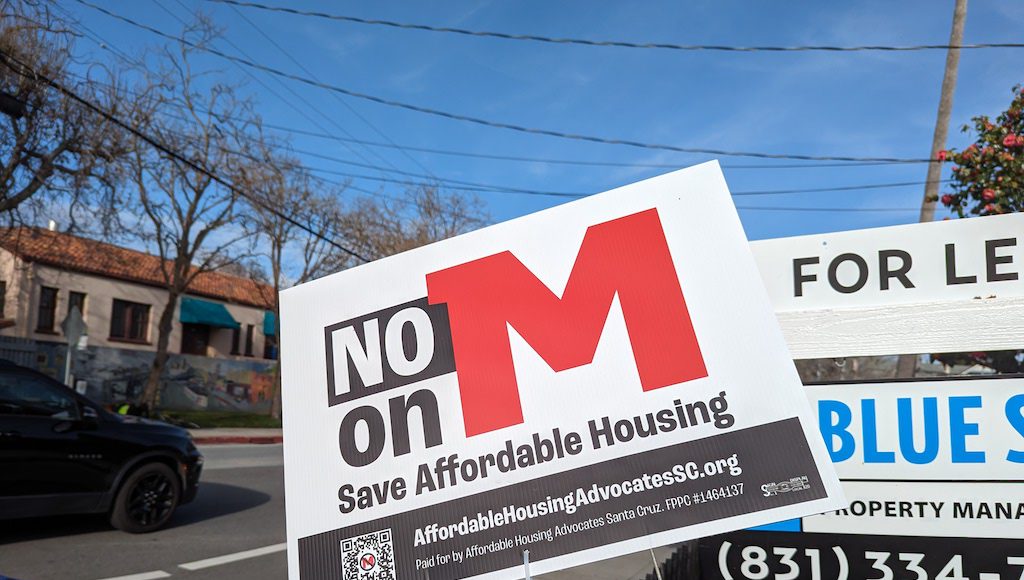It all came down to messaging. Santa Cruz’s Measure M, also known as the Housing For People Initiative, suffered a resounding defeat at the polls last week. Now, even those behind the campaign say the lack of a streamlined message hurt its chances.
Santa Cruz residents rejected the measure’s proposal to increase the affordable housing requirement for developments over 30 units to 25%, as well as the right to vote on building heights that go over the city’s existing height limits.
Updated results posted on March 11 to the Santa Cruz County Election Department’s website show that out of 16,629 total votes cast, 10,080 delivered a “No” vote, killing the measure with a 60.62% majority. Yes voters added up to 6,549, making up the other 38.38%.
In a low-turnout presidential primary, 46.96% of the 36,828 eligible voters in Santa Cruz cast ballots on the measure.
Frank Barron, a retired land use planner and key architect of Measure M, said the campaign’s messaging could have been clearer.
“People I’ve talked to were confused. And I think the opposition really… that’s what they intended to do is to make it more confusing. So they were successful in that,” Barron said.
“But I think that we could have been a little bit better in our messaging as well, just to be more basic, to the point and make it real simple,” he added.
The opposition ran an aggressive campaign that rallied support from numerous pro-affordable nonprofits, including Housing Santa Cruz County and Santa Cruz YIMBY.
Campaign financial disclosures revealed that the NO on M campaign also garnered support from various real estate developers. Milpitas-based Devcon Construction contributed a total of $9,000; Green Valley Corporation of San Jose donated $5,000 and the Santa Cruz Seaside Company gave $5,000.
No on M raised a grand total of $57,294 as of March 5.
By comparison, the Yes on M campaign raised $35,753, mostly from individual contributions. The largest contribution from real estate was from local affordable housing developer Joe Quigg, who gave $1,000.
While the No on M campaign enjoyed a substantial financial advantage, in the end it came down to messaging. Santa Cruz voters were swayed by the No campaign’s argument that raising the inclusionary housing requirement to 25% would scare off developers. In a town at the center of the most expensive rental market in the country, the prospect of losing out on any new affordable housing mobilized voters.
Former Santa Cruz Mayor Don Lane, who was part of the No on M campaign, said that the measure “reached too far” and that while it positioned itself as a pro-housing measure, it would actually hinder affordable housing efforts.
Measure M was born as a response to the Downtown Plan Expansion, which envisions a redevelopment of the South of Laurel neighborhood. A key part of the plan expansion is the construction of a new arena for the Santa Cruz Warriors G-League basketball team. The city initially proposed that areas within the plan expansion be rezoned to accommodate 12 to 17 story buildings as part the new arena project.
After assuming office in January 2023, Santa Cruz Mayor Fred Keeley pushed for the plan to reduce the proposed building heights to 12 stories in response to public input.
Santa Cruz Warriors President Chris Murphy, in an email statement to fans before the election, shared a letter which said that current plans for the arena and adjacent housing would not exceed 85 feet, or roughly 8 stories. The letter encouraged residents to consider voting no on Measure M.
Barron is happy about the reduced building heights the Warriors are now floating.
“Seven or eight stories instead of 12 …that’s a big win as far as we’re concerned, as far as I’m concerned. Because that’s kind of what the current zoning would allow for anyway. And, so, that kind of height would not even trigger a Measure M vote had [it] passed,” Barron said.















Down with the misleading article this publication ran a few weeks prior to the election.
Greed is what led to Measure M’s defeat – greed on the part of this publication included !!
How could height limits and an increase in affordable units be a bad thing?
Propaganda from the No camp (down with D.Lane and Co., ok??!?!?!?!) was misleading and disrespectful to a democratic process.
Bad/sad news all around…